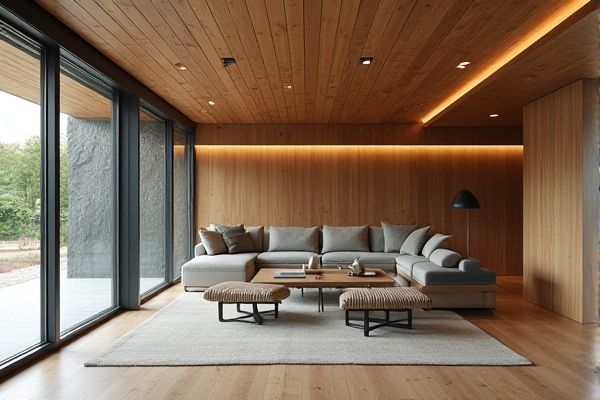
Glass capping offers a sleek, modern look with high durability and low maintenance, while wooden capping provides a classic, warm aesthetic but requires regular upkeep to prevent damage from weather and pests. Discover the pros and cons of each to determine which capping best suits your home's style and your maintenance preferences in the rest of this article.
Table of Comparison
| Feature | Glass Capping | Wooden Capping |
|---|---|---|
| Material | Tempered or laminated glass | Solid wood (oak, pine, mahogany) |
| Durability | High resistance to weather and corrosion | Prone to warping, cracking, and insect damage |
| Maintenance | Low maintenance; easy to clean | Requires regular sealing, painting, or staining |
| Appearance | Modern, sleek, transparent look | Classic, warm, natural texture |
| Cost | Generally higher initial cost | Lower initial cost, but potential long-term costs |
| Installation | Requires professional handling for safety | Easier DIY installation |
| Environmental Impact | Recyclable, but energy-intensive production | Renewable, biodegradable, but may involve deforestation |
Introduction to Capping Materials
Glass capping offers a sleek, modern finish with high durability and resistance to weathering, making it ideal for contemporary architectural designs. Wooden capping provides a natural, warm aesthetic and is favored for its flexibility in customization and ease of installation, though it requires regular maintenance to prevent decay. Your choice between glass and wooden capping should consider factors like environmental exposure, desired visual effect, and long-term upkeep.
What Is Glass Capping?
Glass capping refers to the process of sealing or covering surfaces, edges, or structures with glass panels for protection and aesthetic enhancement. Unlike wooden capping, which uses timber to provide a traditional, warm finish, glass capping offers a modern, sleek appearance while allowing natural light to pass through. The durability and low maintenance of glass capping make it a popular choice for contemporary architectural designs and outdoor installations.
What Is Wooden Capping?
Wooden capping refers to the process of installing a protective and decorative wooden trim along the edges or tops of surfaces such as windows, doors, or fences. This traditional method offers a natural aesthetic, enhancing durability by shielding underlying materials from weather damage while allowing for easy customization through staining or painting. Compared to glass capping, wooden capping provides better insulation and a warmer appearance but requires more maintenance to prevent rot and decay.
Key Differences Between Glass and Wooden Capping
Glass capping offers a sleek, modern aesthetic with superior transparency and durability against weather elements, making it ideal for contemporary architectural designs. Wooden capping provides natural warmth and traditional appeal, but requires regular maintenance to prevent rot, warping, and insect damage. The choice between glass and wooden capping depends on factors like visual preference, maintenance commitment, climatic conditions, and budget constraints.
Durability and Longevity Comparison
Glass capping offers superior durability compared to wooden capping due to its resistance to moisture, insects, and warping, making it ideal for long-term applications. Wooden capping, while aesthetically pleasing, is prone to decay, rot, and requires regular maintenance to extend its lifespan. The longevity of glass capping typically surpasses wooden capping by several years, especially in outdoor or high-humidity environments.
Aesthetic Appeal: Glass vs. Wood
Glass capping offers a sleek, modern aesthetic with its transparent and reflective qualities that enhance natural light and create an open, airy feel in any space. Wooden capping provides a warm, classic look characterized by rich textures and natural grain patterns, adding a cozy and traditional charm. The choice between glass and wooden capping depends on the desired interior style--contemporary elegance versus rustic warmth.
Maintenance Requirements for Each Material
Glass capping requires minimal maintenance, as it is resistant to moisture, staining, and fading, making it ideal for long-lasting durability with just occasional cleaning using mild detergents. Wooden capping demands regular maintenance, including sealing, staining, or painting to protect against weathering, rot, and insect damage, which can increase upkeep costs and effort. The difference in maintenance frequency and methods significantly impacts long-term performance and aesthetic preservation of the material used.
Environmental Impact and Sustainability
Glass capping offers a more sustainable option due to its recyclability and longer lifespan, reducing landfill waste compared to wooden capping which often relies on deforestation and has a shorter durability. Your choice of glass capping supports lower carbon emissions and decreased resource consumption as it can be repeatedly recycled without loss in quality. Wooden capping, while biodegradable, typically requires more frequent replacement, leading to increased environmental impact over time.
Cost Analysis: Glass Capping vs. Wooden Capping
Glass capping typically involves higher upfront costs due to the price of tempered or laminated glass and specialized installation equipment, whereas wooden capping generally has lower initial expenses, driven by the availability of various wood types and simpler installation processes. Maintenance costs for glass capping include potential repairs for chips or cracks and regular cleaning to maintain clarity, while wooden capping may incur expenses related to repainting, sealing, and protection against moisture or pests. Over time, glass capping offers durability and resistance to weather elements, potentially reducing replacement frequency compared to wooden capping, which may require more frequent upkeep and replacement due to wear and environmental degradation.
Choosing the Right Capping for Your Project
Glass capping provides a modern, sleek finish with durable, weather-resistant properties ideal for outdoor projects requiring transparency and minimal maintenance. Wooden capping offers a classic aesthetic with customizable staining options, promoting natural insulation and is preferred for traditional designs where warmth and texture are priorities. Evaluating factors such as environmental exposure, desired appearance, budget, and maintenance will guide the optimal choice between glass and wooden capping for your construction or renovation project.
 homyna.com
homyna.com